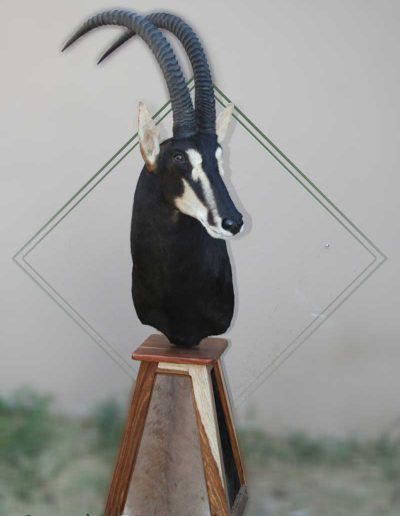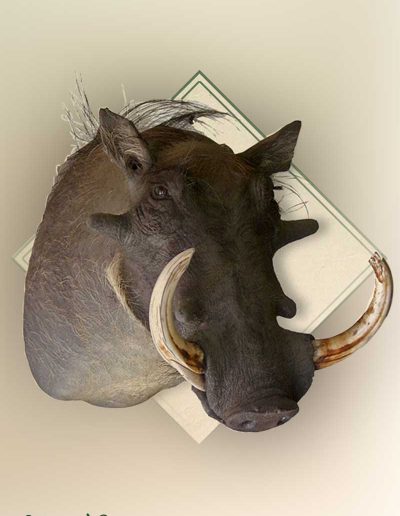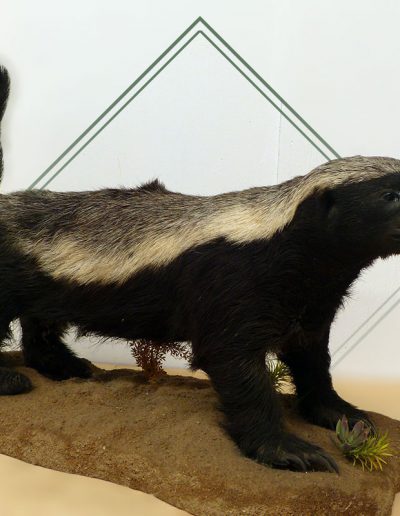Estelle Nel
TAXIDERMY
We are a progressive South African company that specializes in high quality trophies at reasonable prices. We provide a complete personalized taxidermy services that includes mounting of all animals, birds and reptiles to museum quality standards, and shipping worldwide.
Quick Contact
Welcome to Estelle Nel Taxidermy
Estelle Nel Taxidermy is situated in Bela Bela, Limpopo, and was established in 2001. It is owned by Stephen Nel, a dedicated craftsman that spends all his time and efforts towards producing quality mounts and Dip & Pack services to clients all around the world.
Estelle Nel Taxidermy handles exports and imports worldwide and all our facilities are registered and approved by the South African Veterinary Services, a division of the Department of Agriculture. Our facilities are inspected yearly by the authorities to ensure that all local and international regulations are being met.

Pedestal Mounts
These are shoulder mounts, cut rather more artistically at the back and mounted on a pedestal which is usually made of wood.

Birds
Our services also include bird taxidermy. We mount birds portraying them in their natural habitat. Choose from flying to nesting

Shoulder Mounts
A Shoulder Mount or Cape Mount is the most popular Trophy. A Shoulder Mount uses the Cape, Skull and Horns of the animal.

Full mounts
Full mount taxidermy is a must for trophies. Lions, leopard or even lizzards are only really seen in their full glory as full mounts.

Trophies
Once a client has completed a hunt, the outfitter or client can contact Estelle Nel Taxidermy to arrange for the collection of the trophies. After a date and time has been set, we will drive to the outfitter to collect the trophies.
On collection of the trophies, we will inspect each and every item together with a representative from the safari company. Once the trophies have been inspected, they are logged into the Taxidermy Register alongside any notes that may contain extra information. The register is then signed by both parties and a copy is left with the hunting outfitter for their recordkeeping.
Once the trophies have been received at our facility, a file is opened in the name of the client containing all the documentation received in the client’s name. The client will then be contacted via email to confirm collection, whereafter a copy of the taxidermy register and all paperwork received will be sent
Processing of Dip & Pack Trophies
Tagging of Trophies
Once the trophies are delivered to our receiving facility, they are re-checked according to the Taxidermy Register and PH Register. The trophies are then tagged with the number allocated to the client file. Each skull, horn, hide, bone or any other item that is to be exported is tagged with the client’s number. Pictures are taken of the trophies as they have been received and sent to the client for confirmation.
Skull and Horns Process
All skulls, horns and bones are left for a period of a week for a natural sun-drying process. Thereafter they are subjected to a boiling process in a solution of Gelkon PK Degreaser, as per State Veterinary Services (Department of Agriculture) regulations. The degreaser solution assists in the extraction of fat and natural oils in the bones. The skulls and bones are then cleaned of all excess meat and sinews. The skulls, horns and bones are then placed in a bleaching solution of 80% Hydrogen Peroxide, as per State Veterinary Services (Department of Agriculture) regulations, to ensure that the skulls are bacteria free and that any excess oils in the bones are removed. Once the bleaching process has been completed, the skulls are placed in the sun to dry before carefully being placed in the skull room for safe storage. The clients will receive an email informing them of the movement of their trophies throughout the process.
Skin Process
All skins received are subjected to a salt action of at least 30 days where after they are dried and treated with Carbo dust (Carbaryl) as per South African State Veterinary Services (Department of Agriculture) regulations and requirements. These Dip processes should take no longer than three months depending on the condition of the trophies when received. Please note, however, that should a client have any of the following animals in their shipment, the drying process will take a bit longer as we are not able to remove the horns from the skull: Buffalo, Blue Wildebeest, Black Wildebeest and Red Hartebeest. These should only take a maximum of four months for drying.

Crating and Packaging
After the regulatory 90 day quarantine period, as stipulated by State Veterinary Services (Department of Agriculture) and processing, we are able to crate our client’s Dip & Pack trophies. We check each trophy against the initial pictures taken upon receipt. Pictures are then taken of the complete set of trophies before they are crated. After they have been crated, an email is sent to the client to confirm that the trophies have been crated and are awaiting collection from the export company. Each hide is individually wrapped in clear plastic and the skulls in bubble wrap where after it is clearly marked, as per State Veterinary Services (Department Agriculture) regulations. We build our own plywood crates at our facility and are able to custom build our client’s crate to minimize space wastage. All wood products are pretreated and approved for export purposes. Crates are treated with Naphthalene marbles to deter any pests. Each crate is sealed with tamper proof security seals that are marked on the packing list to ensure that our clients receive their trophies in perfect condition. Should the seals be changed at anytime by the export company due to an inspection, new seals will be placed on the crate and a note thereof will be made in the paperwork at the export company. The signed pack list with seal numbers and initial pictures of the trophies are attached to the inside of the lid of the crate for confirmation of what was secured into the crate. The client is emailed to confirm the date that the crated trophies are collected from our premises and to inform them of the contact person that will be handling their shipment at the export company.
Processing of Mounted Trophies
All the trophies that are received at Estelle Nel Taxidermy are handled with the same Dip & Pack procedures in the treatment and cleaning of the trophies. Trophies that are to be mounted are removed from the storerooms for mounting once the job card is ready for mounting.
Mounting Process
When we contact the client via email to confirm that the trophies have been collected, we ask the client to confirm the mounting instructions that we have received on the Taxidermy Register or to provide us with the correct mounting instructions. We need to know the instructions for the trophies and what types of mounts the client would prefer, e.g. pedestal mount, half mount or shoulder mount. We welcome all types of input from the client and encourage as many pictures as possible should there be a different type of mount or action involved in the mount. All trophies that are to be mounted are written on a job card which is issued to our very capable mounters.
Mannequins
Each trophy has a foam mannequin moulded to suit the action required for each trophy as prescribed by the client. This mannequin is then shaped and positioned to fit the skin of the trophy.
Skull & Horns Process
Working from the job card, the skulls and horns are collected from the skull storeroom and checked against the original pictures taken upon receipt of the trophies. Once confirmed, the skulls are then cut to fit onto the foam mannequins that have been made for each trophy, leaving the horn caps, eye sockets and nose bone intact. This section of the skull is them moulded into place onto the mannequin, ready for mounting. Once in place, an email will be sent to the client to confirm whether the direction is correct.
Skin Process
The skins are removed from the skin storeroom and placed in a salt water solution to soften the skin, where after it is thoroughly washed with clean water. The excess water is then allowed to dry off before the skin is placed in a formic acid solution to loosen and remove any sinew and meat residue left on the skin. The formic acid also removes the natural oils from the skin and halts the hair slipping process, should this occur. The skin is then removed from the formic acid and shaved to the correct thickness for mounting—all residual sinew and meat is then removed. The eyes, lips and ears are then split and any areas that have holes or cuts are stitched to create an even surface. The skin is then placed in a solution of Lutan F, which tans the skin and reintroduces synthetic oils, which keep the skin supple for mounting and extend the life span of the trophy.
The skin is then fitted to the mould to ensure that it is not overstretched and that the mould is adjusted accordingly. Clay is used to form the smaller detail on the face area and placement of the glass replica eyes. Once everything is in position, the trophy is checked by management and sent for drying. After the drying process has been completed, the trophies are sent to our trophy artists for the finishing touches and “makeup”. Here the finer details are added to bring the trophies to life. Once all the trophies in a client’s shipment are completed, pictures are taken and sent to the client to confirm that crating will be taking place. The trophies are then crated by our skilled team and safely secured to ensure that they do not move.
Crating and Packaging
We build our own plywood crates at our facility and are able to custom build our client’s crate to minimize space wastage. Trophies are crated and safely secured by a skilled team to ensure that the trophies do not move. Trophies are secured to the sides of the crates with tamperproof screws and supported by struts to minimize movement while in transit. The struts are covered with bubble wrap to ensure that the trophies do not rub against the struts and cause damage. Crates are treated with Naphthalene marbles to deter any pests. Each crate is sealed with tamper proof security seals that are marked on the packing list to ensure that clients receive their trophies in perfect condition. Should the seals be changed at anytime by the export company due to an inspection, new seals will be placed on the crate and a note thereof will be made in the paperwork with the export company.
Documentation
By Hunting Outfitter
The following documentation must be provided by the Hunting Outfitter in order for the export permits to be issued for the client:
- A signed copy of the PH Register with all the necessary permit numbers and penned in dates.
- Signed TOPS hunting permits for any TOPS species that have been hunted—depending on the province.
- Signed CITES hunting permits for any CITES species that have been hunted.
- Valid P3 Exemption permit from the landowner where the hunt took place.
- Permission to hunt letter from the landowner where the hunt took place.
- All paperwork must have the client’s residential address.
Hunting Permits
When planning to hunt species that require hunting permits, please ensure that the permit is signed on all pages by all relevant parties.
The permit is not legal if it is not signed by all relevant parties. Hunting animals without the required permits is illegal and can result in having a client’s trophies confiscated if any discrepancies are found by the Nature Conservation Authorities.
Export Permits
All export permit applications are handled by our skilled office staff. Copies of the received documentation are kept in the client’s file while originals are sent through with the permit application.
Permits can take up to ten weeks to be issued, depending on what is applied for and if all the information is filled in correctly on the paperwork. Any species hunted outside the Limpopo Province require verification from the other provinces, which must accompany the permit application.
It is the outfitter’s obligation to the client to ensure that all the details on the paperwork are correct and that everything is signed where it needs to be signed. Clients must please ensure, when signing the PH Register, that their residential address is listed and that it is correct.
CITES export permits can take a bit longer as verification is often needed from other offices in the province where the trophy was hunted. The waiting period for CITES permits is 90 days, so species such as monkeys, baboon, lion and hippo will take at least three months to be issued. Animals such as leopard and lion (any CITES 1 species) must have an import permit issued in the client’s name, this must be sent through to us as timely as possible before we are able to apply for the export permit.
Contact Us
079 876 2287
We are located on the same premises as Camo Meat. Learn More about Camo Meat . Camo Meat is a registered venison exporter.
















































